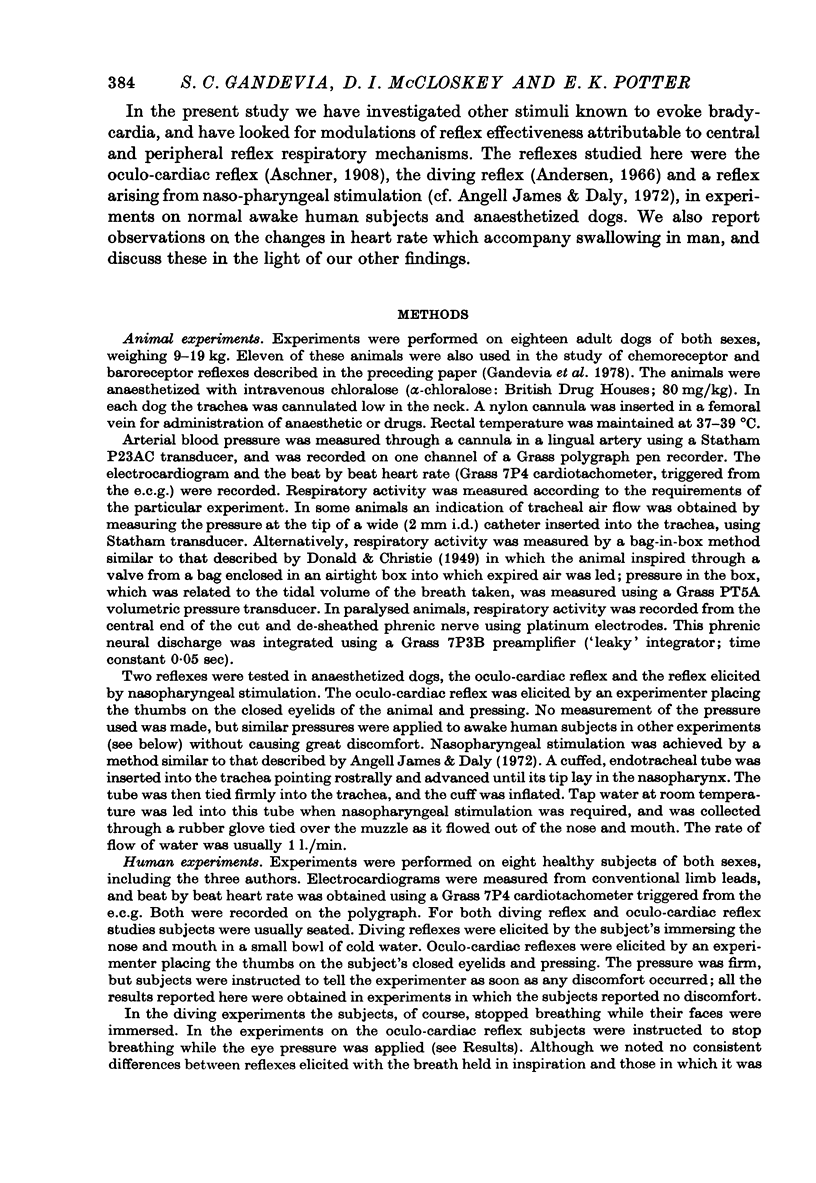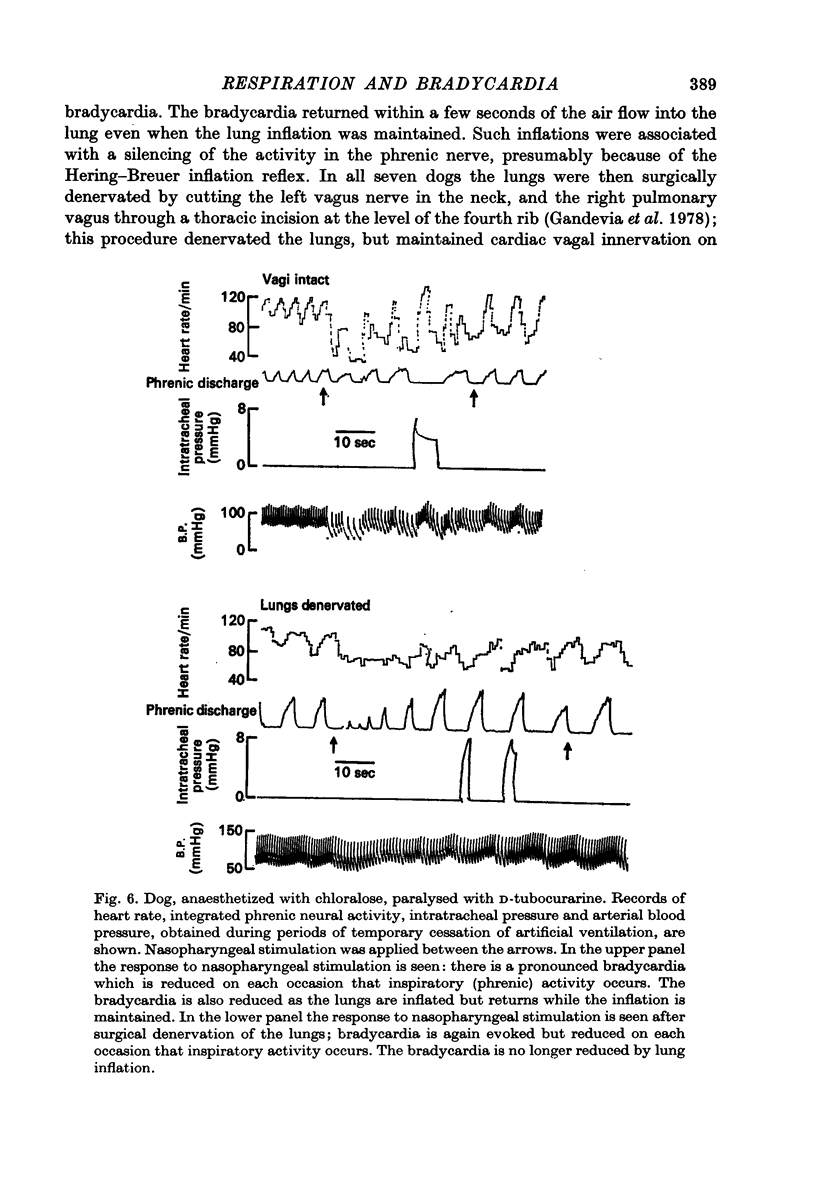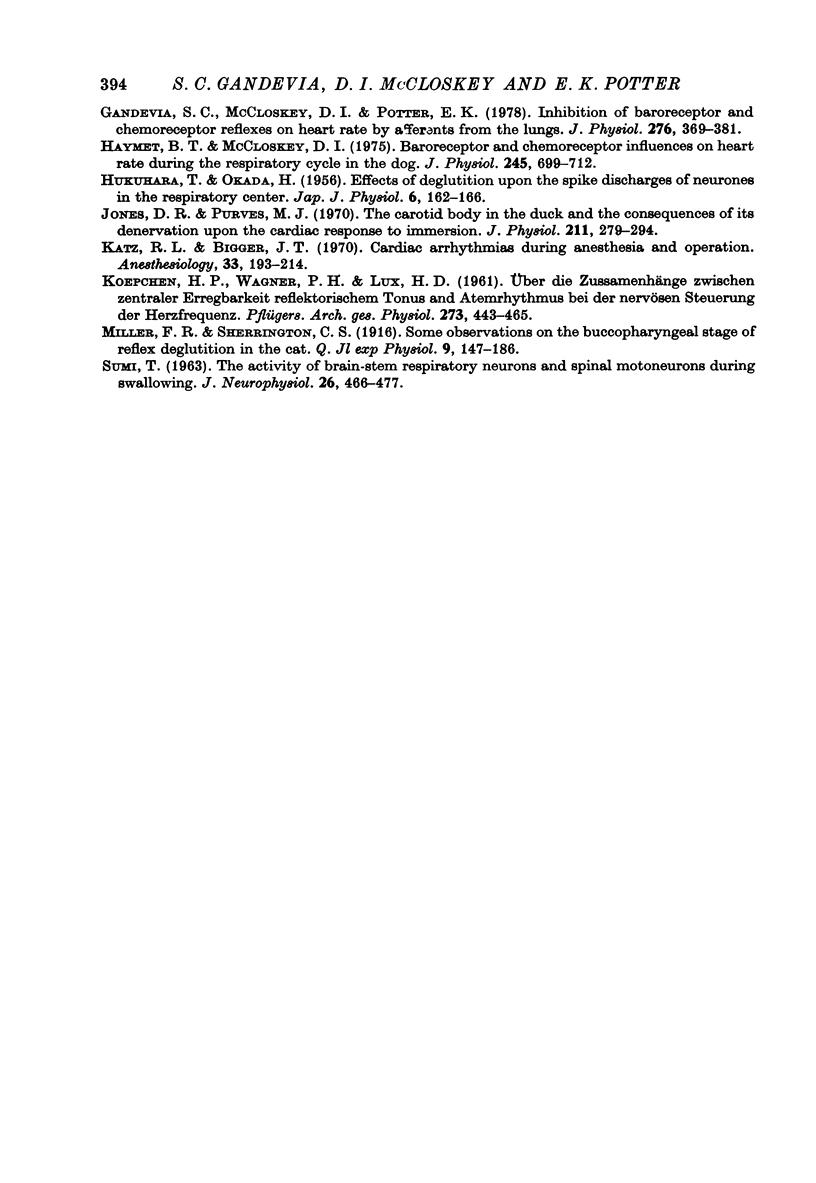Abstract
1. Digital pressure applied to the eyes evokes reflex bradycardia in human subjects and anaesthetized dogs. The bradycardia is most pronounced when breathing stops. 2. In the dog oculo-cardiac reflex bradycardia is mediated by vegal stimulation and by sympathetic withdrawal. 3. Oculo-cardiac reflex bradycardia in the dog is reduced by central neural inspiratory activity and by the excitation of pulmonary afferents by inflation of the lungs. In human subjects it is reduced when inspiratory efforts are made against a closed glottis. 4. Nasopharyngeal stimulation with water evokes reflex bradycardia in the anaesthetized dog. This bradycardia is reduced by central neural inspiratory activity and by the excitation of pulmonary afferents by inflation of the lungs. 5. Bradycardia occurs in normal human subjects during immersion of the face in water ('diving'). This bradycardia is reduced when inspiratory efforts are made against a closed glottis. 6. Swallowing evokes transient tachycardia in human subjects. During diving or the application of ocular pressure, swallowing reduces the reflex bradycardia which these evoke.
Full text
PDF











Selected References
These references are in PubMed. This may not be the complete list of references from this article.
- ANDERSEN H. T. Factors determining the circulatory adjustments to diving. I. Water immersion. Acta Physiol Scand. 1963 Jun-Jul;58:173–185. doi: 10.1111/j.1748-1716.1963.tb02639.x. [DOI] [PubMed] [Google Scholar]
- ASERINSKY E., DEBIAS D. A. Suppression of oculocardiac reflex by artificial respiration. Arch Ophthalmol. 1963 Apr;69:484–491. doi: 10.1001/archopht.1963.00960040490012. [DOI] [PubMed] [Google Scholar]
- Andersen H. T., Blix A. S. Pharmacological exposure of components in the autonomic control of the diving reflex. Acta Physiol Scand. 1974 Feb;90(2):381–386. doi: 10.1111/j.1748-1716.1974.tb05599.x. [DOI] [PubMed] [Google Scholar]
- Bamford O. S., Jones D. R. Respiratory and cardiovascular interactions in ducks: the effect of lung denervation on the initation of and recovery from some cardiovascular responses to submergence. J Physiol. 1976 Aug;259(3):575–596. doi: 10.1113/jphysiol.1976.sp011484. [DOI] [PMC free article] [PubMed] [Google Scholar]
- Davidson N. S., Goldner S., McCloskey D. I. Respiratory modulation of barareceptor and chemoreceptor reflexes affecting heart rate and cardiac vagal efferent nerve activity. J Physiol. 1976 Jul;259(2):523–530. doi: 10.1113/jphysiol.1976.sp011480. [DOI] [PMC free article] [PubMed] [Google Scholar]
- Davis A. L., McCloskey D. I., Potter E. K. Respiratory modulation of baroreceptor and chemoreceptor reflexes affecting heart rate through the sympathetic nervous system. J Physiol. 1977 Nov;272(3):691–703. doi: 10.1113/jphysiol.1977.sp012067. [DOI] [PMC free article] [PubMed] [Google Scholar]
- Gandevia S. C., McCloskey D. I., Potter E. K. Inhibition of baroreceptor and chemoreceptor reflexes on heart rate by afferents from the lungs. J Physiol. 1978 Mar;276:369–381. doi: 10.1113/jphysiol.1978.sp012240. [DOI] [PMC free article] [PubMed] [Google Scholar]
- HUKUHARA T., OKADA H. Effects of deglutition upon the spike discharges of neurones in the respiratory center. Jpn J Physiol. 1956 Jun 15;6(2):162–166. doi: 10.2170/jjphysiol.6.162. [DOI] [PubMed] [Google Scholar]
- Haymet B. T., McCloskey D. I. Baroreceptor and chemoreceptor influences on heart rate during the respiratory cycle in the dog. J Physiol. 1975 Mar;245(3):699–712. doi: 10.1113/jphysiol.1975.sp010869. [DOI] [PMC free article] [PubMed] [Google Scholar]
- James J. E., De Burgh Daly M. Reflex respiratory and cardiovascular effects of stimulation of receptors in the nose of the dog. J Physiol. 1972 Feb;220(3):673–696. doi: 10.1113/jphysiol.1972.sp009729. [DOI] [PMC free article] [PubMed] [Google Scholar]
- Jones D. R., Purves M. J. The carotid body in the duck and the consequences of its denervation upon the cardiac responses to immersion. J Physiol. 1970 Dec;211(2):279–294. doi: 10.1113/jphysiol.1970.sp009279. [DOI] [PMC free article] [PubMed] [Google Scholar]
- Katz R. L., Bigger J. T., Jr Cardiac arrhythmias during anesthesia and operation. Anesthesiology. 1970 Aug;33(2):193–213. doi: 10.1097/00000542-197008000-00013. [DOI] [PubMed] [Google Scholar]
- SUMI T. The activity of brain-stem respiratory neurons and spinal respiratory motoneurons during swallowing. J Neurophysiol. 1963 May;26:466–477. doi: 10.1152/jn.1963.26.3.466. [DOI] [PubMed] [Google Scholar]
- de Burgh Daly M., Elsner R., Angell-James J. E. Cardiorespiratory control by carotid chemoreceptors during experimental dives in the seal. Am J Physiol. 1977 May;232(5):H508–H516. doi: 10.1152/ajpheart.1977.232.5.H508. [DOI] [PubMed] [Google Scholar]


